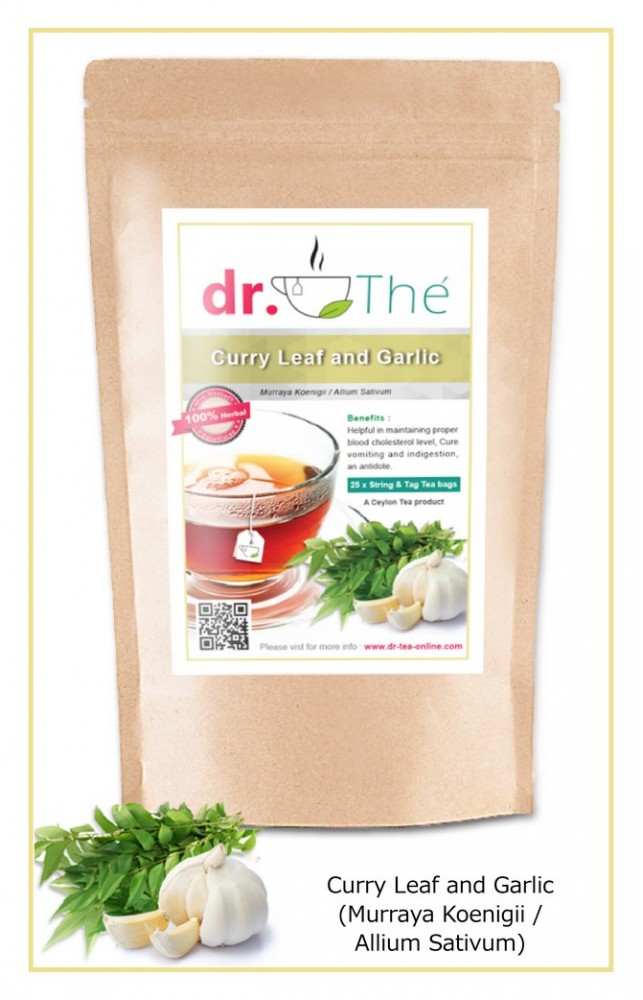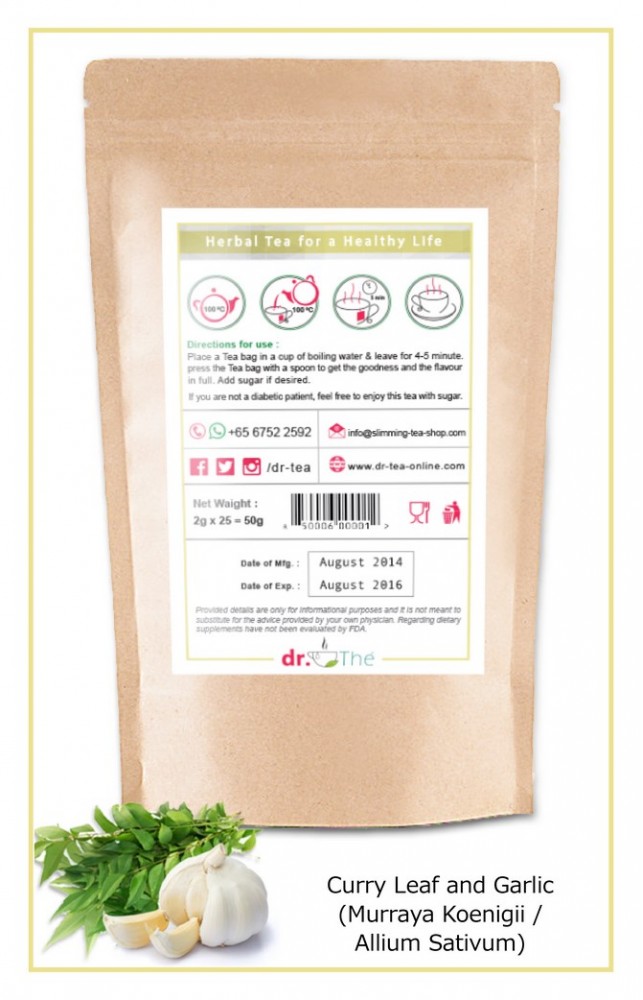Curry Leaves/Sweet Neem Leaves- The curry tree (Murraya koenigii or Bergera koenigii) is a tropical to sub-tropical tree in the family Rutaceae (the rue family, which includes rue, citrus, and satinwood), which is native to India and Sri Lanka.
Its leaves are used in many dishes in India and neighbouring countries. Often used in curries, the leaves are generally called by the name 'curry leaves,' although they are also literally 'sweet neem leaves' in most Indian languages.
In medicine
Stops Diarrhea: Research studies conducted by Ashish Pagariya and Maithili, V. concluded that the carbazole alkaloids present in curry leaves or Murraya Koenigii had anti-diarrheal properties. Experiments on lab rats showed that carbazole extracts from curry leaves had significantly controlled castor oil-induced diarrhea. A bunch of curry leaves can be ground up and the paste can be eaten or the juice of the leaves can be consumed.
Gastrointestinal Protection: Use of curry leaves is recommended as a cure for gastrointestinal issues in Ayurvedic methodology. One important is due to the fact that they are considered to possess mild laxative properties. Make juice out of a bunch of curry leaves and add lime juice. This mixture is to be consumed for indigestion or a paste made from the leaves can be added to buttermilk and taken every morning on an empty stomach.
Antioxidant Properties: Research studies conducted by Mylarappa B. Ningappa et al. at Jawaharlal Nehru Center for Advanced Scientific Research, Molecular Parasitology and Protein Engineering Laboratory in Bengaluru, India have indicated that curry leaves or Murraya Koenigii is a good source of antioxidants. The presence of various vitamins like vitamin A, B, C and E help in reducing oxidative stress and free radical scavenging activity. Curry leaves can be added to your curries, vegetable stews and soups. They are also available in dried powder form.
Anti-Diabetic Properties: Perhaps one of the biggest health benefits of curry leaves is its use in diabetes control. Research conducted by the Department of Biochemistry and Molecular Biology at University of Madras, Chennai had shown that the anti-hyperglycemic properties of curry leaves were beneficial in controlling blood glucose levels in diabetic rats.
Fights Cancer: The chemical constituents found in curry leaves such as phenols are helpful in fighting cancers such as leukemia, prostate cancer and colorectal cancers. Research on curry leaves at the Department of Medical Chemistry at Mejio University, Japan showed evidence of cancer fighting properties in the carbazole alkaloids extract from curry leaves.
Lowers Cholesterol Levels: Curry leaves are also known to reduce bad LDL cholesterol level. Studies conducted at the Department of Biochemistry at the University of Kerala, India have shown that curry leaves have the potential to reduce LDL cholesterol levels.
Good for Hair Growth: Curry leaves are believed to help in strengthening hair roots. Dry curry leaf powder mixed in oil can be applied to your hair with a quick massage. The paste from curry leaves can also be applied in cases of gray hair. Doing these on a regular basis can improve hair growth as well.
Good for Eyesight: Curry leaves contain high amounts of vitamin A and are therefore good for eyesight. Vitamin A contains carotenoids which protect the cornea, which is the eye surface. Deficiency of vitamin A may cause night blindness, cloud formations in front of the eye and even the loss of vision loss in some cases.
Radio-Protective and Chemo-Protective: Studies on the extracts of curry leaves have shown positive results in reducing the effects of chemotherapy and radiotherapy, while also offering protection against chromosomal damage, protection of bone marrow and prevention of free radicals becoming active in the body.
Protects Against Pathogen Attack: Research on curry leaves has revealed that they are also effective in fighting bacterial and fungal infections. The leaf extracts from the plant have been comparable to popular, mainstream antibiotic drugs.
Protects the Liver: Your liver plays a major role in the digestive system and it needs to be protected from any attack by free radicals, as well as viral and bacterial attacks that can result in infection. Research on curry leaves has indicated that the tannins and carbazole alkaloids present in curry leaves exhibited good hepato-protective properties. They are also helpful in protecting the liver from various diseases such as hepatitis and cirrhosis.
Skin care: Curry leaves are also helpful in skin care. The juice or paste of the leaves can be applied on burns, cuts, bruises, skin irritations and insect bites for quick recovery and clean healing.
Garlic (Allium sativum) - Its close relatives include the onion, shallot, leek, chive, and rakkyo. With a history of human use of over 7,000 years, garlic is native to central Asia, and has long been a staple in the Mediterranean region, as well as a frequent seasoning in Asia, Africa, and Europe. It was known to Ancient Egyptians, and has been used for both culinary and medicinal purposes.
In medicine
Cholesterol:
A multitude of medical studies confirm that garlic in several forms can reduce cholesterol. In the most recent study, using garlic pills and a placebo, researchers at Oxford University noted a 12 per cent reduction in total cholesterol.
Coronary artery disease is caused by a build-up of plaque within the arterial system. Studies have found that garlic appears to inhibiting new growth of plaque.
Pregnancy:
Research from gynaecologists at the Chelsea and Westminster Hospital in London showed that taking garlic during pregnancy can cut the risk of pre- eclampsia, a potentially dangerous condition affecting one in ten pregnant women and causing raised blood pressure and protein in the urine.
Some studies also reveal that garlic may help to boost the birth-weight of babies destined to be too small.
Researchers found that taking standardised garlic tablets throughout pregnancy may decrease the chances of these types of complications at birth.
They found that adding extracts of garlic to the placental cells of women likely to suffer from these conditions stimulated growth.
In addition, the activity of key enzymes that are reduced in abnormal pregnancies where these conditions can occur were significantly increased when garlic was added.
Antiseptic:
Garlic is the only antibiotic that can actually kill infecting bacteria and, at the same time, protect the body from the poisons that are causing the infection. In studies, garlic has been found to be almost as effective as penicillin, while recent research shows similar activity to a more modern antibiotic called chloramphenicol, used for typhoid fever as well as conjunctivitis.
Even the blood of people who eat garlic can kill bacteria, and it is also reported that the vapour from freshly-cut garlic can kill bacteria from a distance of 20cm.
In the past, garlic used to be used to treat tuberculosis, as the invading organism, mycobacterium tuberculosis, is sensitive to several of the sulphur components found in garlic.
Impotence
For centuries, garlic has been used by holistic healers as an aphrodisiac as it was thought to increase blood supply to the genitals.
However, more recent studies have found that an enzyme called nitric oxide synthase is primarily responsible for the mechanism of erection. Studies have recently shown that garlic can stimulate the production of nitric oxide synthase.
Cancer:
There is a wealth of information published on the role of garlic in preventing cancer. Most research today is centred upon establishing which particular compounds, after allicin, are most active in inhibiting the growth of cancer cells.
Some very recent research from the U.S. proved that by injecting diallyl disulphide - formed when raw garlic is cut or crushed - into the bloodstream, tumours can be reduced by up to a half.
The research also found that another compound in garlic, called S-Allylcysteine, is effective in preventing cancer-causing agents from binding to human breast cells.
Other research found that increased garlic intake reduced nitrite levels in the body and resulted in fewer deaths from stomach cancer. It is also well known that garlic can help to strengthen the immune system, which is vitally important for fighting cancer.
Stomach ulcers:
Modern medical studies have found that numerous diseases - gastric ulcers, ulcerative colitis, coronary artery disease, Kaposi's sarcoma and cervical cancer to name but a few - are triggered by infectious processes caused by bacteria or viruses. Garlic may be helpful in treating or preventing some of these conditions.
Recent discoveries by Australian scientists show that stomach ulcers are either caused by the helicobacter pylori bacteria, or contributed to by it, and that garlic can relieve ulcers as it kills this type of bacteria.
Other research has found that conditions such as Crohn's disease and ulcerative colitis may also be inflammatory diseases caused by or contributed to by the mycobacterium paratuberculosis bacteria, which again can be killed by eating raw garlic.
Blood clotting:
Garlic is an anticoagulant and could be helpful in protecting against the blood clots which can cause strokes. If you are taking aspirin to keep your blood from forming clots, garlic may be a more pleasant and natural alternative.
Mixing aspirin or other blood-thinning medicines with garlic can be dangerous under some circumstances though. Always consult your GP before taking garlic supplements in conjunction with medications for blood thinning.
Digestion
Allicin promotes the secretion of gastric juices by stimulating the mucous membranes of the stomach. It also combines with the stomach's natural proteins, reducing the excessive activity which can lead to indigestion.
In addition, allicin regulates the functioning of the stomach by activating the large intestine, so helping guard against constipation and diarrhoea.





